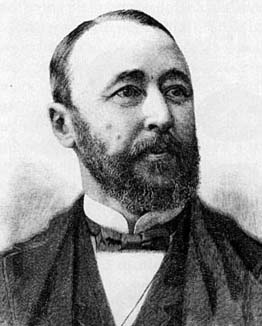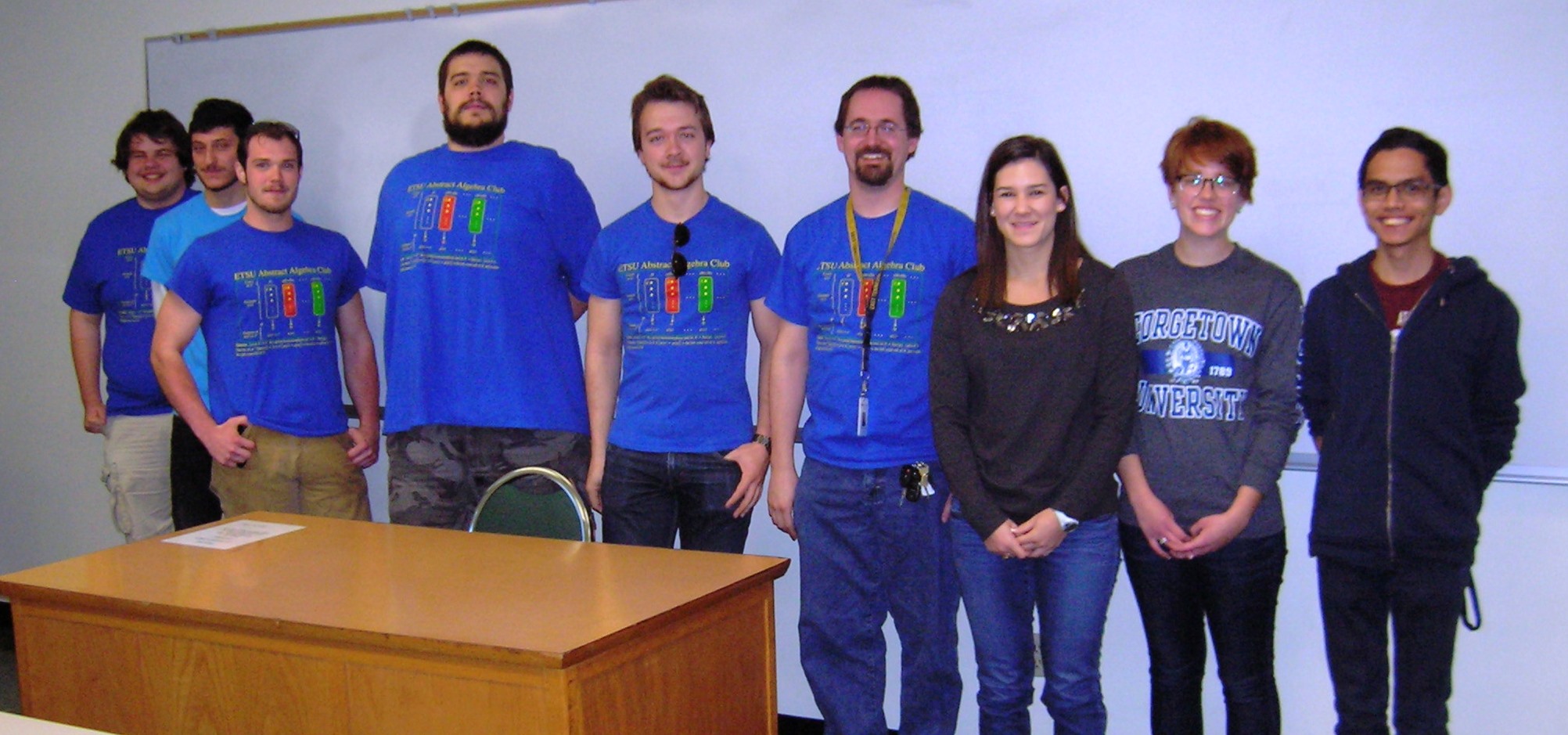 Niels Henrik Abel, 1802-1829 |
 Evariste Galois, 1811-1832 |
 Peter Ludwig Sylow, 1832-1918 |
 Emmy Noether, 1882-1935 |
 Niels Henrik Abel, 1802-1829 |
 Evariste Galois, 1811-1832 |
 Peter Ludwig Sylow, 1832-1918 |
 Emmy Noether, 1882-1935 |

COURSE: MATH 4137/5137-001, Call # 13498
TIME AND PLACE: 9:45-11:05 TR in Burleson Hall room 202
INSTRUCTOR: Dr. Robert Gardner OFFICE HOURS: 11:15-12:00 TR
OFFICE: Room 308F of Gilbreath Hall
PHONE: 439-6979 (308F Gilbreath), Math Department Office 439-4349
E-MAIL:gardnerr@etsu.edu
WEBPAGE: http://faculty.etsu.edu/gardnerr/gardner.htm
(see my webpage for a copy of this course syllabus, copies of the classnotes in PDF, and updates for the course).
TEXT: A First Course in Abstract Algebra, 7th edition, by John B. Fraleigh (2002).

CLASS NOTES: We will use overheads for component of the lecture consisting of definitions, statements of theorems, and some examples. I will use the white board for additional examples and proofs of theorems. Copies of the notes are online at: http://faculty.etsu.edu/gardnerr/4127/notes2.htm It is strongly recommended that you get printed copies of the overheads before the material is covered in class. This will save you from writing down most notes in class and you can concentrate on listening and supplementing the notes with comments which you find relevant. You should read the online notes to be covered in class before each class (we may not have class time to cover every little detail in the online notes). Try to understand the definitions, the examples, and the meanings of the theorems. After each class, you should read the section of the book covered in that class, paying particular attention to examples and proofs.
ADDITIONAL REFERENCES:
Visual Group Theory by Nathan Carter, New York: Mathematical Association of America, 2009. I will use this resource for some motivational and geometric examples.
Algebra by Thomas W. Hungerford, New York: Springer-Verlag, 1974. This is a standard graduate level algebra textbook. I will lightly rely on it for deeper results and proofs (some of which are omitted from out text).
A History of Abstract Algebra, by Isreal Kleiner, Boston: Birkhauser, 2007. As time permits, I will insert some historical comments and this is be a reliable source of such information.
PREREQUISITES: As the ETSU catalog states, the prerequisite for this class is Introduction to Modern Algebra (MATH 4127).
HOMEWORK: YOU MUST SHOW ALL DETAILS ON THE HOMEWORK PROBLEMS!!! Justify every step and claim you make - this is how you convince me that you know what you are doing. Partial answers to some of the odd numbered problems are given in the back of the book. However, these answers are not explained in any level of detail, so you are required to provide all details. Homework problems will be due on Fridays and, as time permits, I will address specific questions in class during the week of the Friday assignment.
ACADEMIC MISCONDUCT: While I suspect that you may work with each other on the homework problems (in fact, I encourage you to), I expect that the work you turn in is your own and that you understand it. Some of the homework problems are fairly standard for this class, and you may find proofs online or in an online version of the solutions manual. The online proofs may not be done with the notation, definitions, and specific methods which we are developing and, therefore, are not acceptable for this class. If I get homework from two (or more) of you that is virtually identical, then neither of you will get any credit. If you copy homework solutions from an online source, then you will get no credit. These are examples of plagiarism and I will have to act on this as spelled out on ETSU's "Academic Integrity @ ETSU" webpage: http://www.etsu.edu/academicintegrity/faculty.aspx (last accessed 7/21/2013). To avoid this, do not copy homework and turn it in as your own!!! Even if you collaborate with someone, if you write the homework problems out in such a way that you understand all of the little steps and details, then it will be unique and your own work.
GRADING: Your grade will be determined by the average on the homework assignments. Grades will be assigned based on a 10 point scale with "plus" and "minus" grades being assigned as appropriate (based on grade points assigned by the university, on a plus/minus 3 point system). Occasionally, the homework assignments will include bonus problems, but there are no other options for extra credit.
DESIRE2LEARN: I will not rely on the Desire2Learn ("elearn") website. Instead, I will simply post all material directly on the internet. However, I will post your homework grades on D2L.
SYLLABUS ATTACHMENT: You can find an on-line version of the university's syllabus attachment (which contains general information concerning advisement, honor codes, dropping, etc.) at: http://www.etsu.edu/reg/documents/PDF/Syllabus_Attachment.pdf (last accessed 10/30/2013).
PRE-FINALS WEEK POLICY: The week before finals week is called "Pre-Finals Week" (the week of December 2 this semester). ETSU has a policy which is explained both in the ETSU Faculty Handbook and the ETSU Student Handbook stating that instructors cannot administer finals during Pre-Finals Week (the primary exception being lab classes). You can access the Student Handbook and Pre-Finals Week policy online at: http://catalog.etsu.edu/content.php?catoid=7&navoid=295 (last accessed 7/21/2013). KNOW YOUR RIGHTS! You have the right to take your finals during finals week and you should be provided the proper amount of time to prepare for your finals. The specific policy from the Student Handbook is (emphasis added by me):
| "The following policy will apply only to undergraduate courses taught during the fall and spring semesters. Activities pursued within the classroom during Pre-Finals Week shall be at the instructor’s discretion within the guidelines set forth in this policy as dictated by TBR regulations. Classes will continue to meet at their regularly scheduled time periods during the last week of formal classes. Under no circumstances will this week be used for final examinations. Exceptions shall be made for laboratories. It is recommended that at least some portion of the last week of classes be used as a review period, when appropriate. The scope and duration of such review will be determined by the instructor. Because communication between instructor and student is of utmost importance, faculty will strive to keep the student informed of his/her progress throughout the semester. This process will continue through the last week of classes as much as is possible for the instructor. Faculty will avoid unscheduled tests, quizzes, or other unscheduled work during this final week of class. Exceptions to this, of course, are make-up tests and make-up assignments." |
NOTE: Introduction to Modern Algebra (MATH 4127) left off right at the point when the topics of "modern algebra" were starting to overlap with what we think of as "classical algebra." We will pick up where we left off and see extension fields, discuss the real numbers (in particular, algebraic and transcendental numbers), and develop the complex numbers as an algebraic extension of the real numbers. We will explore algebraic solutions of polynomial equations and attain our "basic goal" of showing that there is no algebraic solution of a 5th degree polynomial equation (this will be the climax of the two semester undergraduate algebra sequence!!!). Following this, we will further examine topics from group theory (namely, the Sylow Theorems and free groups). Finally, we will explore factorization.
We will first cover parts V (Ideals and Factor Rings), VI (Extension Fields), and X (Automorphisms and Galois Theory). Then, we will backtrack and cover parts VII (Advanced Group Theory) and IX (Factorization), as time permits.
GRADUATE LEVEL MODERN ALGEBRA: The department will offer the graduate level class Modern Algebra 1 (MATH 5410) in fall 2015. The prerequisite is Intoduction to Modern Algebra (MATH 4127/5127) and admission into the math master's program. It will be taught by Dr. Bob and will cover many familiar topics: groups, subgroups, homomorphisms, cyclic groups, cosets, normal subgroups, quotient groups, direct products, finitely generated abelian groups, solvable groups, subnormal series, rings, and ideals. We will also cover some new topics: categories, free groups, generators of a group, free abelian groups, group action on a set, and the Sylow Theorems. Unlike the undergraduate class, the graduate class will concentrate much more heavily on theorems and proofs. Modern Algebra 1 meets part of the core requirement for our math master's degree. More details are online at: http://faculty.etsu.edu/gardnerr/5410/sillab-fall15.htm.
IMPORTANT DATES: (see http://www.etsu.edu/etsu/academicdates.aspx for the official ETSU calendar; accessed 11/9/2014):
Our tentative schedule is as follows:
| |
| |
||||
V.31. Algebraic Extensions |
7-13 |
|||
VII.34. Isomorphism Theorems |
3 (modified), 5 (modified) |
|||
VII.35. Series of Groups |
1 (modified, 7 (modified), 23 |
|||
X.49. The Isomorphism Extension Theorem |
Bonus: 1 |
|||
X.53. Galois Theory |
4-6, 12 (modified) |
|||
Return to
Bob Gardner's home page
Last updated: April 27, 2015.